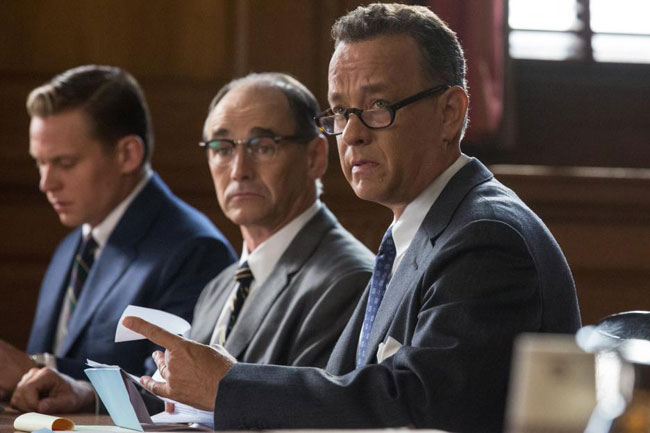
Dreamworks Pictures
Almost since the dawn of cinema, movies have been a tool to depict historic events whether in a factual way, or by incorporating history into a piece of fiction. A lot of films usually stick to some historical event that we may be familiar with, be it wars, natural disasters, or stunning achievements, but it’s rare for a film — or a filmmaker — to tackle a piece of history most people aren’t familiar with.
One filmmaker has done it several times now, from using a forgotten moment from World War II to create an outlandish comedy, to focusing on one of the world’s greatest horrors and a virtually unknown man who saved the lives of thousands. Now, Steven Spielberg is taking a story from the Cold War era that has some familiarity to it and adds a new layer that many people have either forgotten or simply don’t know about.
Bridge of Spies tells the overlapping stories of two (three actually) governments and the efforts to learn each other’s secrets without getting caught. On the American side, the CIA has pressed into service four pilots to fly spy missions over the USSR with instructions to destroy their planes if damaged and kill themselves if captured. One pilot, Francis Gary Powers, was unable to do either and was captured by the Soviets.
In New York, a suspected Soviet spy, Rudolf Abel, was already in custody, tried in a kangaroo court, and was facing the death penalty. His appointed lawyer, James B. Donovan, was able to convince the biased judge not to give Abel the death penalty just in case the US needed him as leverage should one of its boys fall into Soviet hands. It was a good thing the judge listened because with Powers’ capture, Abel was the leverage needed to get him back and Donovan was tasked, as a US citizen instead of an agent of the government, to arrange an exchange between the two governments. And then another US citizen was detained in East Germany just as the Berlin Wall was going up, complicating Donovan’s mission and playing on his patriotism. One false move could derail the entire negotiations once the Germans got involved.
Bridge of Spies shows Spielberg firing on all cylinders. It may not be the most action-packed film of the year, and it certainly screams “OSCAR BAIT,” but the story itself is engrossing enough to make you forget all of that. There are no flashy camera moves — but there is a pretty spectacular moment when Powers’ plane is shot out of the sky — but the film still looks absolutely gorgeous and period perfect. The attention to detail of the era is spot on, and if it weren’t for the presence of Tom Hanks, one would think the film was made sometime in the 1960s.
Of course, Tom Hanks also does what Tom Hanks does best, playing the down-to-earth Everyman with a style and grace, never being showy about it, that really seals the deal on him being our modern day James Stewart. Stewart definitely could have played this role in 1965 or so, and Hanks dons the mantle Stewart left behind. The only drawback is that you are always reminded that this is Tom Hanks so, even though he’s great in the role, it does take you out of the story just a tiny bit.
Especially when he’s surrounded by a cast of virtually unknown faces (outside of Alan Alda as Donovan’s boss). The real standout of the cast is Mark Rylance as Abel. Rylance gives Abel a very quiet demeanor, very calm and collected even when faced with a room full of Federal agents searching his apartment for evidence of his spying activities. He’s so cool, in fact, that Donovan asks him at key points in the film — like when he’s facing the electric chair — if he’s worried. Abel’s response is always, “Would it help?” showing a bit of his dry humor in the face of some serious matters. Rylance matches Hanks beat for beat, and I wouldn’t be surprised to see him get some Supporting Actor nods come awards season.
Bridge of Spies is certainly not as heavy a subject matter as Schindler’s List, but by the end when you see Donovan’s lifetime achievements, it can be argued that he was the American Schindler. It may impress viewers with the period detail but the film itself is anything but flashy. Some may find it slow moving, while others will find themselves immersed in the gripping story and the era Spielberg and his crew have created, spotlighting real events that many have forgotten today. If you’re a history buff or just want to see a filmmaker at the top of his craft, you can’t go wrong with Bridge of Spies.


